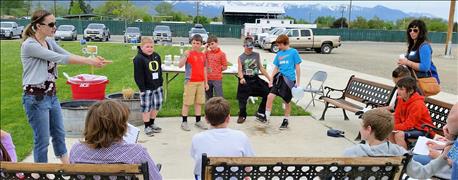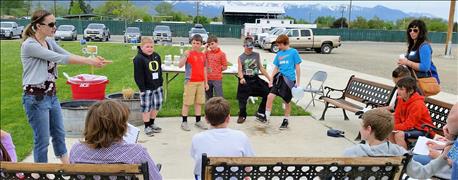November 19, 2016

Editor's Note: This continues the seventh installment in our Focus on Spuds series. In this part, we look at the specifics of one farmer's investment in the crop; and family involvement in an important state organization.
Though potatoes comprise less than 20% of the acres farmed by Logan Kerns and his family, they represent the most important crop in terms of potential profits.
But “potential” is a point of emphasis, says Kerns, because of the amount of money that goes into a potato crop.

POINT TAKEN: Holly Kerns, wife of Oregon farmer Logan Kerns, leads a Baker County Farm Bureau Field to Fork activity, which teaches local young people about everything from water conservation to how farm crops make their way to tables across the globe.
“It’s a terribly, terribly expensive crop to grow,” Kerns says. “If you get hit by a late spring frost or an early frost late in the growing season, that can really hurt production. And we’re always fighting things like nematodes and aerial pests.”
Kerns says that in the area of eastern Oregon where his family farms, growers can generally get $2,200 to $2,700 per acre for their spuds, but they can also put up to $2,000 per acre into the crop.
“You can get rewarded for growing potatoes, but there’s also a lot of risk out there,” he says. (Behind cattle, potatoes are the second-leading agricultural commodity in Baker County, with annual sales hovering around $12 million.)
Kerns and his father, Brent, farm about 1,000 deeded acres and 200 rented acres in the high desert Baker Valley. And since his grandfather, Mac, retired from the U.S. Forest Service, he enjoys helping with decision-making.
In addition to potatoes, they grow winter wheat and alfalfa.
Each year, Kerns and his family raise about 200 acres of Russet Burbanks. The fields are normally in a seven-year rotation, which helps cut down on disease problems. Potatoes are typically followed by winter wheat for two years and alfalfa for four.
“Wheat is not terribly profitable up here, but it grows pretty well behind potatoes because potatoes leave a lot of nutrients in the ground,” Kerns says. “Because of that, we don’t have lot of input costs with the wheat so we can make that crop work.”
The area only receives about 10 inches of precipitation, so farmers rely on irrigation water. The Kerns use both center pivots and hand lines.
“Conditions are pretty ideal for potatoes, in part because of our cool nights,” he says. “The area grows really good potatoes; the quality is fantastic.”
The 34-year-old Kerns says that he loves farming.
“There is a lot of gratification watching a crop grow and produce, plus I get to work with my kids, Dad, my grandfather and nephews,” he says.
On this particular summer day, Kerns is working on a pivot, hauling hay and transplanting squash and melons while watching over his two young children, two nephews and one of their friends.
“During summer, my kids are with me almost every day while I work, and that is something I really enjoy,” says Kerns, whose wife, Holly, works in town as the Baker County planning director.
“Without her working, I couldn’t afford to be a farmer,” he says.
Family farms embrace Farm Bureau
Oregon farmer Logan Kerns and his wife, Holly, like many farm and ranch families across the country, are actively involved in Farm Bureau.
Logan is president of Baker County FB while Holly, the county’s planning director, has been active with local Farm Bureau events such as Field to Fork, which teaches elementary students about the many things that go into producing the food they eat.
“There are so many aspects to agriculture, and we want to share that information with the kids,” says Holly, who discusses such topics as water usage and conservation as the kids participate in hands-on activities like building an erosion control device.
Additional stations emphasize other aspects of agriculture including commodities, ag production and transportation.
Field to Fork, which is patterned after Farm Bureau’s Ag in the Classroom, has become a major event in Baker City since its inception nearly a decade ago, drawing support each year from groups like Baker County FB, Extension and soil and water conservation districts along with some 80 volunteers.
Area farmers donate food for lunches, including potatoes and corn, as well as materials for Field to Fork demonstrations.
Among the active volunteers is Baker County FB member Eugene Hawes, a fifth-generation farmer and rancher who raises hay, cattle and wheat.
“I really think we’re making a difference in these kids’ understanding about how important agriculture is,” says Hawes, who was recognized for his many years of county and state involvement with a Service to Farm Bureau Award at the 83rd annual Oregon FB meeting last December.
“And I think they have fun,” he adds.
You May Also Like




